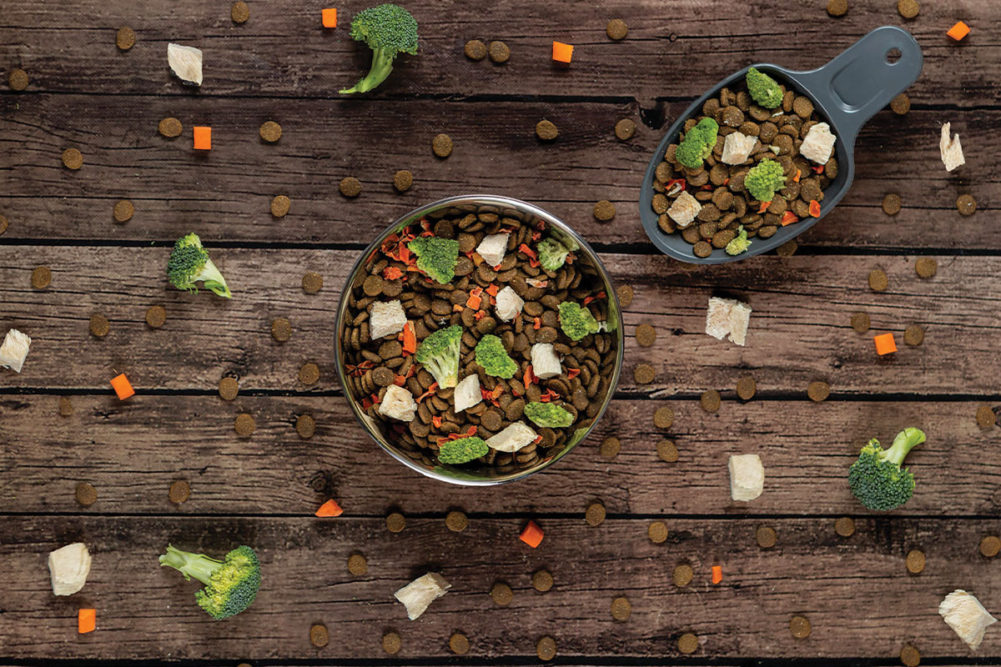This article was published in the November 2023 issue of Pet Food Processing. Read it and other articles from this issue in our November digital edition.
Pet parents buy with their eyes. Even the pickiest of pets does not care about visual appeal. For them, it’s all about taste, texture and smell.
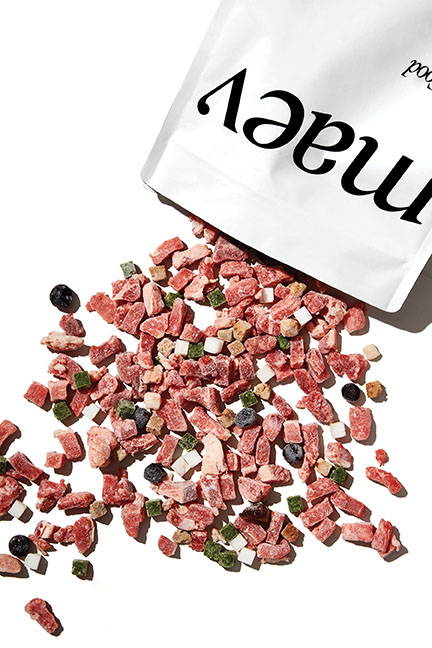
Pet parents shop with their eyes, which is why pet food with visually identifiable ingredients can be more appealing.
|“Pets don’t read the label or care about the pretty package; however, the pet parent typically does,” said Brett Sher, head of research and development and chief of operations, Evanger’s Dog and Cat Food Company and Against the Grain Pet Foods, Markham, Ill. “Evanger’s has always used whole pieces of veggies in our wet foods because it does in fact have a visual appeal to the customer. The pet parent is able to clearly see what ingredients and how much is being added to the food. In addition, foods with whole fruits and vegetables have more of a home-cooked look, which is what we are mimicking just on a large scale.”
Looks matter
Thirty-three percent of US pet owners say the ingredients in their pet’s food influences their purchasing decisions, according to Innova’s Category Insider: Trends in Pet Food, March 2023.
“Specifically, they are looking for safe, quality food with ingredients that offer complete nutrition and are natural/clean label,” said Vicki Gawlinski, director of content and communications, Van Drunen Farms, Momence, Ill. “Fruit and vegetable pieces are easy to identify ingredients that pet owners are comfortable eating themselves, which gives them confidence that they are also beneficial for their pets.”
Robert Mason, applications technologist, Balchem Animal Health and Nutrition, Montvale, NJ, said, “Pet parents want their pets to ‘eat like them.’ Anything that can differentiate your product from competitors helps to draw consumer attention. This is especially true as historically pet feed and treats are extruded, brown pellets, so anything producers can do beyond this imagery can further market their products.”
A Better Dog Food from A Better Treat, Los Angeles, is an ambient kibble product that includes freeze-dried, recognizable chunks of raw salmon or chicken and broccoli, along with air-dried carrots. Freeze drying enables the retention of more than 60% of vitamins and minerals compared to dehydration or cooking, according to the company.
“We pride ourselves in being the only kibble product you can take a picture of and recognize the ingredients,” said Julie Chen, head of strategy at A Better Treat. “Seeing the chunks of meat or fish helps speak to the quality of the food one is feeding their pet. It helps make pet parents feel more at ease knowing that their pet is getting high-quality, nutrient-dense protein.”
“Fruit and vegetable pieces are easy to identify ingredients that pet owners are comfortable eating themselves, which gives them confidence that they are also beneficial for their pets,” said Vicki Gawlinski, Van Drunen Farms.
The kibble component functions as the carrier for added nutrients, including vitamins, minerals, fiber and probiotics. These nutrients are often added as isolated compounds.
New York-based Maev spent three and a half years working with veterinary nutritionists to formulate its human-grade raw food for dogs. The product contains flash-frozen identifiable pieces of raw food, including beef, green beans, zucchini, kale and blueberries, and does not require thawing prior to feeding.
Natural Balance Pet Foods Inc., Burbank, Calif., has developed Platefulls homestyle meals. Recipes feature beef, chicken or duck with identifiable vegetables, such as carrots, kale, peas, potatoes and pumpkin, cooked in bone broth. The wet ambient stews come in pouches and require refrigeration after opening.
Ingredient toolbox
Including whole pieces of animal protein is not always feasible from a cost perspective, or even from a sustainability angle, as doing so could take proteins away from the human edible market. Formulators have several options for creating the appearance of authentic meat or fish chunks in both wet and dry pet food formats.
“In wet pet food manufacturing, texturizing ingredients, such as functional proteins, gums and starches, can be added to ground meat mixtures to create a texture that is more similar to real meat or fish,” said Brittany White, senior director of product development, applied research and innovation, Simmons Pet Food and Simmons Animal Nutrition, Siloam Springs, Ark. “Another option is textured vegetable proteins, which are often made from plant-based materials, such as soy, wheat or pea. These can be processed to mimic the texture of meat or fish pieces and are commonly used in both wet and dry pet food formulations.”
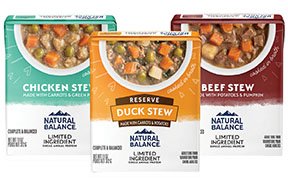
Platefulls homestyle meals from Natural Balance Pet Foods Inc. feature beef, chicken or duck with identifiable vegetables, such as carrots, kale, peas, potatoes and pumpkin, cooked in bone broth.
|Mason said, “You can use trim meats, scraps and other off-cuts that are typically underutilized. Our structure and forming materials offer a way to bind or form these materials into whole-muscle-like formats that can be processed into finished particles that market to pet parents.
“With any forming system, some degree of visible muscle fiber will be necessary to have the most natural visual,” he added. “In other words, you cannot start with an emulsified puree and make it look like striated muscle, but you can take a course ground cut or trimmings and bind them into a steak-like piece.”
Such technology may also be used to produce inclusions designed to simulate fruits and vegetables. They are typically lipid based and provide an inert way to liven up the food. These types of fabricated inclusions also allow for the addition of extra nutrition. This includes everything from fiber to support gut health to glucosamine for joint health.
“It is important to understand the losses of these nutrients that may occur during processing and storage to ensure the final product delivers the amount of nutrients declared on the packaging and to deliver the desired nutritional benefit,” White said.
With some fruits and vegetables, the real deal is necessary. Replicating broccoli florets is not possible… yet.
“Whole foods are seen as a preferred choice because they offer a natural and comprehensive way to meet nutritional needs while promoting overall health and vitality,” Chen said. “Nutrients in whole foods also typically are more bioavailable and contain phytonutrients, which are often missing in synthesized supplements.”
Elisa Gumbel, director of marketing, Tree Top Inc., Selah, Wash., said, “Our fruit ingredients add sweetness, fiber and nutritional value to pet product formulation. With more pet parents buying with their eyes, we have been getting more requests for our dehydrated apple pieces.”
Dehydration allows for ambient distribution and storage of the ingredient. It lowers freight costs, too, as no one is paying to ship water. The pieces can be used in kibble or added to wet food, with extra water added to the formula to rehydrate the pieces.
“Our fruit ingredients are also used in toppers, which are generally wet mixtures poured over dry kibble,” Gumbel said. “They contain fruit and vegetable purees, often with apple pieces, to visually communicate the inclusion of real fruit.”
Tree Top has developed numerous kibble topper recipes. An apple, pumpkin, cranberry with chicken powder is designed to appeal to the pickiest eaters, while apple, butternut squash, spinach with quinoa adds plant protein, iron and lots of fiber.
Van Drunen Farms offers freeze-dried fruit and vegetable pieces. They retain the color, shape, flavor and nutrients of fresh, offering formulators the opportunity to conveniently incorporate fruit and vegetable ingredients into their applications, according to Galinski.
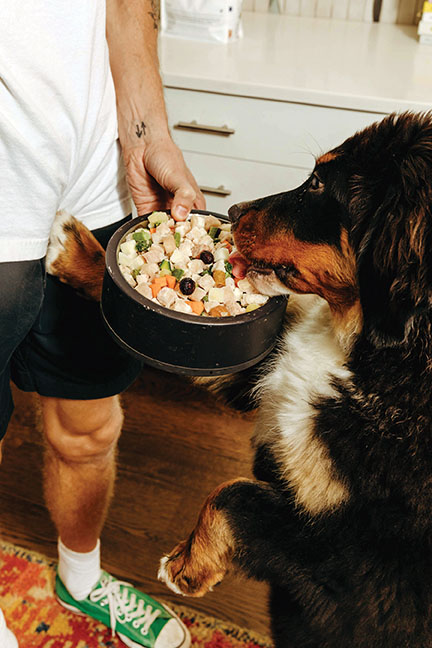
Maev’s human-grade raw food for dogs contains flash-frozen, identifiable pieces of raw food, including beef, green beans, zucchini, kale and blueberries.
|Fun inclusions applied as toppings are showing up in pet-friendly cakes, cookies and ice cream. This includes colorful chips, edible glitter and sprinkles. Puppy Cake LLC, Portersville, Pa., for example, includes Pupfetti Sprinkles in a number of its human-grade dog dessert mixes. The blue and pink topping is semolina based and colored with beet juice or spirulina and finished with a mica-based pearlescent pigment.
“We have noticed an increasing trend of pet food products being colored with a variety of natural sources, including fruits and vegetables,” said Ashlee Martin, senior application scientist, Oterra, Denmark. “Natural sources, such as black carrot, annatto or turmeric are easily recognizable.”
Alice Lee, technical marketing manager, GNT USA LLC, Dallas, NC, said, “Our expansive plant-based color portfolio of 400 shades derived exclusively from fruits, vegetables and plants, aligns seamlessly with this ethos. Processed using familiar, kitchen-like methods such as boiling and chopping, these colors offer an ideal solution for adding vibrancy and visual appeal to pet food items, especially in fun inclusions in pet-friendly cakes and cookies.”
Ensuring piece integrity
Whole food ingredients are minimally processed and can present a number of challenges. Fruits and vegetables, for example, may bleed color into the surrounding product. Active enzymes may cause structural breakdowns and discoloration. Undesirable interactions may take place between the inclusion and the base food matrix.
“Providing engagement through differentiated pet food that pushes past the traditional brown-and-round goes far beyond what an in-house formulator does,” said Heather Govea, chief commercial officer, Alphia, Denver. “Alphia has a dedicated R&D team that can assist to ensure the quality and standard deviation of the piece sizes remain consistent and meet customer standards and expectations.”
“Ensuring piece integrity from the processing plant to the food bowl involves careful handling, processing and quality control throughout the supply chain,” said Brittany White, Simmons Pet Food.
White said, “Ensuring piece integrity from the processing plant to the food bowl involves careful handling, processing and quality control throughout the supply chain. The key is selecting a high-quality starting material in the right form, whether it is fresh, frozen or dehydrated.”
Controlling pH is also important, especially in shelf-stable products, as a higher pH may cause food safety issues.
“But adding raw or unprotected acids can cause further issues with both the formula itself or the fruits and vegetables,” Mason explained. “We recommend adding encapsulated acidulants to provide pH control, but without that damaging shock from using raw acids. A sequestrant or chelation agent may be necessary if free radicals are being introduced to prevent oxidation reactions.”
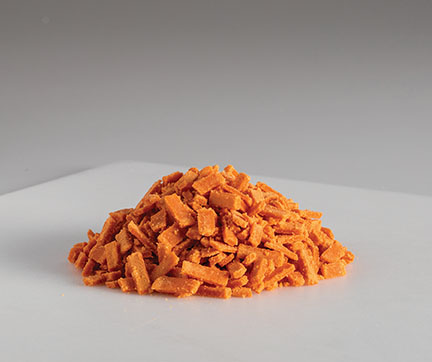
Balchem’s lipid-based pumpkin inclusions add color and aroma to baked pet treats with minimal impact on moisture content or product formulation.
| Source: Balchem Animal Nutrition and HealthWhite said, “Dehydrated fruits and vegetables are typically the most resistant to physical breakdown during processing, followed by frozen, then fresh. Formulators also have to understand the processing conditions that the pieces will be required to withstand. If there’s an option to add the visible inclusions later in the process, for example, after mixing, that will help ensure they maintain their integrity.”
Antioxidants may be added to preserve color. It’s also important to control water activity to prevent microbial growth after processing and during storage.
“Finally, packaging is a critical component to ensure that the products are protected from moisture migration, light and oxygen to ensure integrity during transportation and storage,” White concluded. “It is important for formulators to conduct appropriate shelf-life testing to assess any physical or chemical changes that may occur in the product with inclusions over time.”
Read more about product development, ingredients and formulation.

